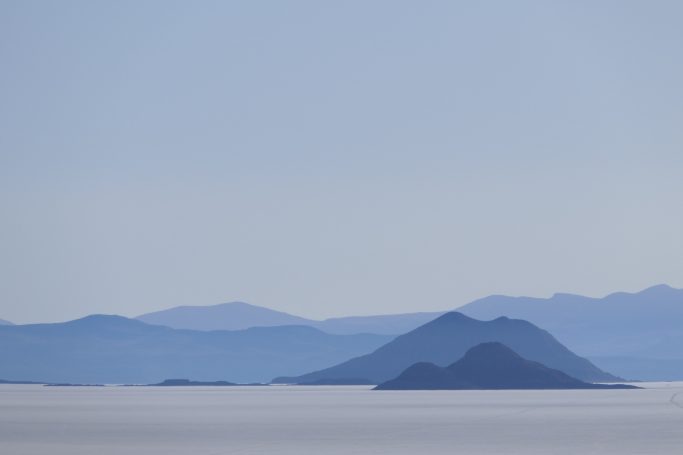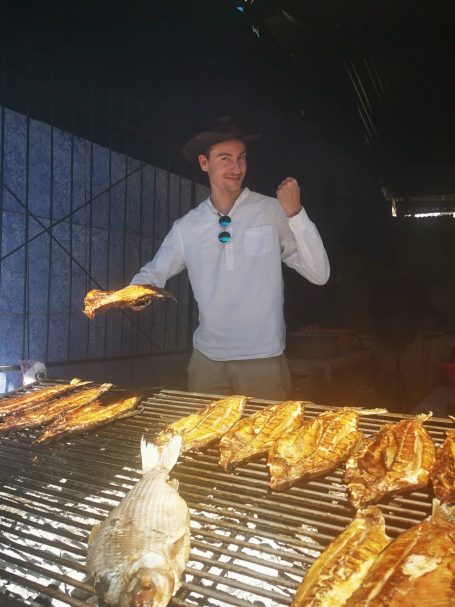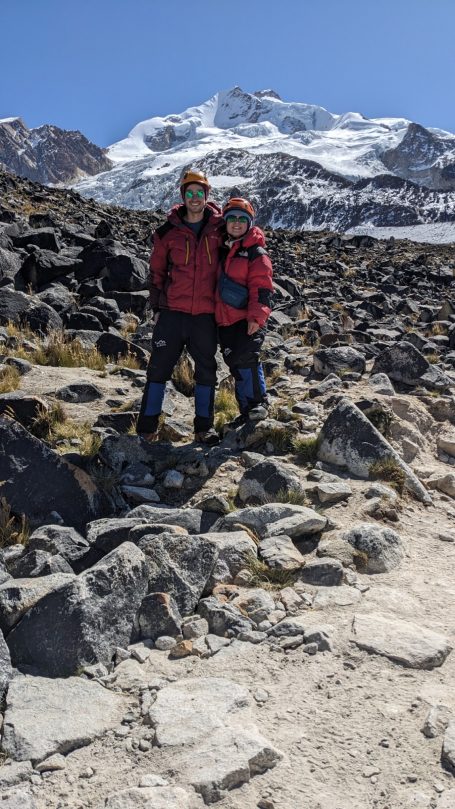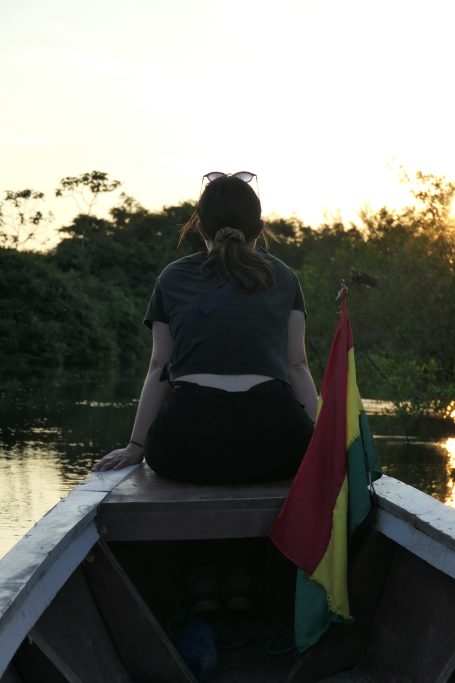Adiós Bolivia loca
***Deutsche Version***
After an endless wait on the other side of the roadblock, the bus finally arrived for our rescue, and we reached our first destination, Uyuni. From here, we started our first big adventure in Bolivia, the largest salt desert in the world—Salar de Uyuni.

Salar de Uyuni—the largest salt desert in the world
We booked our tour via WhatsApp a few days in advance. Without WhatsApp, you are really lost in South America. Whether you want to book an excursion or a bus, reserve a restaurant or even call the police in Bolivia, you do it via WhatsApp.
We were lucky to drive through the highlands in a 4x4 jeep with two cool, hilarious Danes and our guide. We had a lot of fun on the long drives through the vast expanses of the salt desert and nature reserves. We played Swiss, Danish and Bolivian music, sang loudly to well-known songs and pestered our guide on various topics. The salt desert is 11’000 km², more than a quarter of Switzerland. We have never seen anything comparable before. It is an endless white expanse with perfect polygon shapes on the surface. These are created by subterranean capillaries of water that rise upwards due to pressure. Besides the Salar, we visited various lagoons and reserves with lots of wildlife and spent the evening under the glittering starry sky in a natural hot spring.

Culture shock in Potosí
In the west, Bolivia is a country located on a high plateau. Therefore, the body needs some time to get used to the altitude. The heart beats much faster than usual, you feel extremely thirsty and must go to the toilet constantly (not only Jana but even Dominik). This was no different in Potosí, one of the highest cities in the world at 4100 m above sea level. In Potosí, this became even more apparent as we strolled through the narrow streets. From time to time, our lungs were filled with the exhaust fumes of the scrap cars, a very unpleasant feeling. The hardcore altitude training will be worth it, as we will learn later.
Potosí is located at the foot of the “Cerro Rico”, which translates as the rich hill. Through the colonisation of the Spanish, the silver of the mountain was mined, and Potosí became one of the wealthiest cities in South America. The silver deposits were so immense that even roads were built with silver paving stones because other materials were more expensive. The story is nevertheless very tragic. Countless miners of Latin American as well as African origin lost their lives in the dangerous mines. After the silver deposits at Cerro Rico dried up, the town became one of the poorest in Bolivia. Many still live off the marginal silver remains in the collapsing local mountain. Some of these mines are now open to tourism.
It’s definitely only something for hard-bitten people. The adventure already started with a visit to the “mercado de los mineros”, where you buy offerings for the miners. Here, you can purchase coca leaves, cigarettes, beer, 98 per cent alcohol or even dynamite. These offerings are given in the pitch-dark tunnels to the “Tio” (Dios), the guardian of the mine. This statue is visited by every “minero” for protection before each working day. On the day of our tour, the Andean New Year was just being celebrated, and we had the “pleasure” of a truly disturbing event. A special ritual is performed for each mine, for which several lamas are sacrificed. The blood is splashed over the entrance to the mine, and the innards are presented to the Tio as offerings. The lamas are skinned in the dirt in front of the mine entrance, and the meat is grilled on the spot and washed down with lots of alcohol. Everyone helps, from the youngest to the grandmothers of the mine workers. The ritual is meant to protect the workers in the mine from the countless dangers of everyday life.
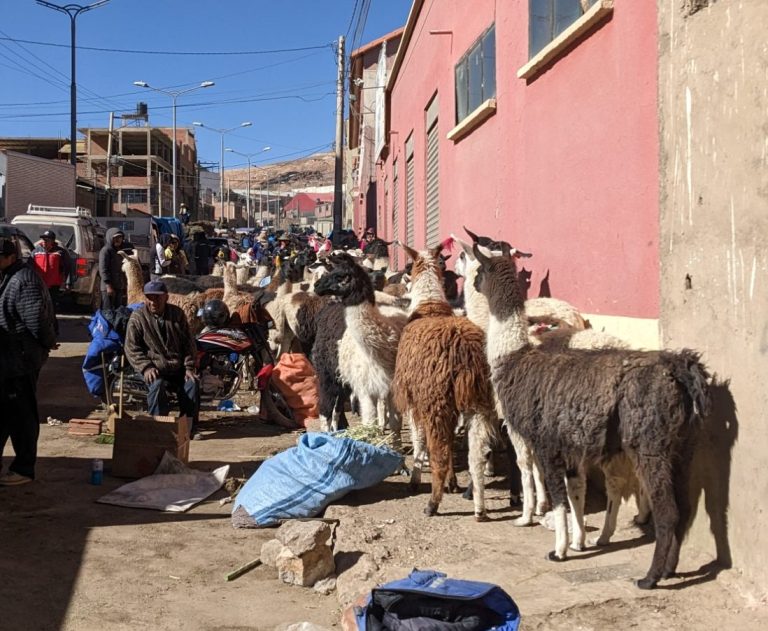
After this crazy experience and the overwhelming impressions, we prepared ourselves for a rather leisurely guided city tour in the afternoon. But even there, we were not spared, as you can imagine. The market halls completely overturned our general understanding of hygiene. When we thought we had seen everything, we came to the last row, where desiccated lama fetuses or dead stuffed baby lamas were sold. They bring luck and are often buried under the foundations of new houses. After the tour, we both felt the urgent need for a shower to get rid of the smell and dirt of the experience. However, the scent of these lamas, or actually the smell of the incense sticks, remains forever burned into our memories.
Spanish language course in beautiful Sucre
The next day, the journey should continue to Sucre, the white city of Bolivia. As it turned out, this Sunday was the annual car-free day in Potosí. Curiously, this also meant that the entire bus station was closed. Of course, nobody was interested in the fact that we had a valid ticket for 10 a.m.
As there were no taxis either, we tried our luck on foot and took a 40-minute walk to find a bus. This time without all the exhaust fumes of the cars, but with all our luggage, again unwilling altitude training! Unsuccessfully, we wandered around for ages. Eventually, we found one. However, we had to wait a few hours, as the bus only left once it was full. In Sucre, the opposite day took place — a car race. Because of this, the anyway long journey took even longer. Completely exhausted, we arrived in Sucre about eight hours late.
Already the next morning, our Spanish course started, which we had booked for five days. Five days is a short time, but we made a lot of progress and, above all, dared to speak. Apart from that, we spent the week exploring the city and its many cafés and restaurants. We also got to know Bolivian walleyball at a school activity. This is volleyball, where you can use the walls—totally funny.



This week, we made it our ritual to drink a fresh “jugo” every day at the market. There were numerous stalls, and when you turned into the section, the “juice women” were already waiting to serve you. So, every day, we got to know a new unknown fruit at the stall of our favourite juice woman. On Saturday, we took a stroll around the local fish market. You can pick your own fish from the different booths, and they serve it with various sauces, potatoes and corn. They also serve a jug of sweet red wine, which you shouldn’t spill on your trousers, as Dominik learned.
We incredibly loved Sucre—the city centre with its colonial architecture, the numerous white buildings, the well-kept parks, the cleanliness and the friendly people. Up to this day, it is still one of our absolute favourite Latin American cities.
Our wild experiences in La Paz
By night bus, the journey continued to La Paz. It was a steep ride up the winding roads of the Bolivian Altiplano. This time, prepared with a sleeping bag and cap, the bitterly cold journey posed no problems, and we reached El Alto just two hours late at sunrise. The city stretches from 3,600 to 4,000 m above sea level, is pretty crazy and overwhelming, especially after the cosy stay in Sucre. The walk from the bus terminal to the hostel was a first taste of the Andean city. On the way, the indigenous Cholitas tried to offer us their “salteñas”, a kind of liquid-filled empanadas, or “papas rellenas”, stuffed and deep-fried potato dumplings. Even the words “no gracias” are exhausting to say at this altitude. Everything was chaotic as many people were already on the road in the early morning hours. Alone, crossing the streets in this city is not an easy undertaking. Panting, we reached our hostel after all.
Our first encounter in La Paz was with Crazy Dave. An American originally from Puerto Rico who had to serve 14 years in the notorious San Pedro prison for drug smuggling. The story of Crazy Dave is definitely a highlight in storytelling, theatre arts and dance performances. San Pedro is not just any prison; it is run entirely autonomously. The jail in the middle of the city is only guarded from the outside by the corrupt Bolivian police. What happens inside the walls is left to the inmates. So drugs are produced and consumed there, parties are celebrated, and strippers are hired. But only as long as you have money to bribe the police. Until recently, tourists could even spend the night there, consume drugs and have wild parties with a contribution to the police’s pocket. In the meantime, however, this has been banned. We would like to tell you more about this crazy prison, but there is actually a book by a British inmate in which he tells his incredible story about his stay in San Pedro. Beware, the book is highly captivating and has great potential for addiction.
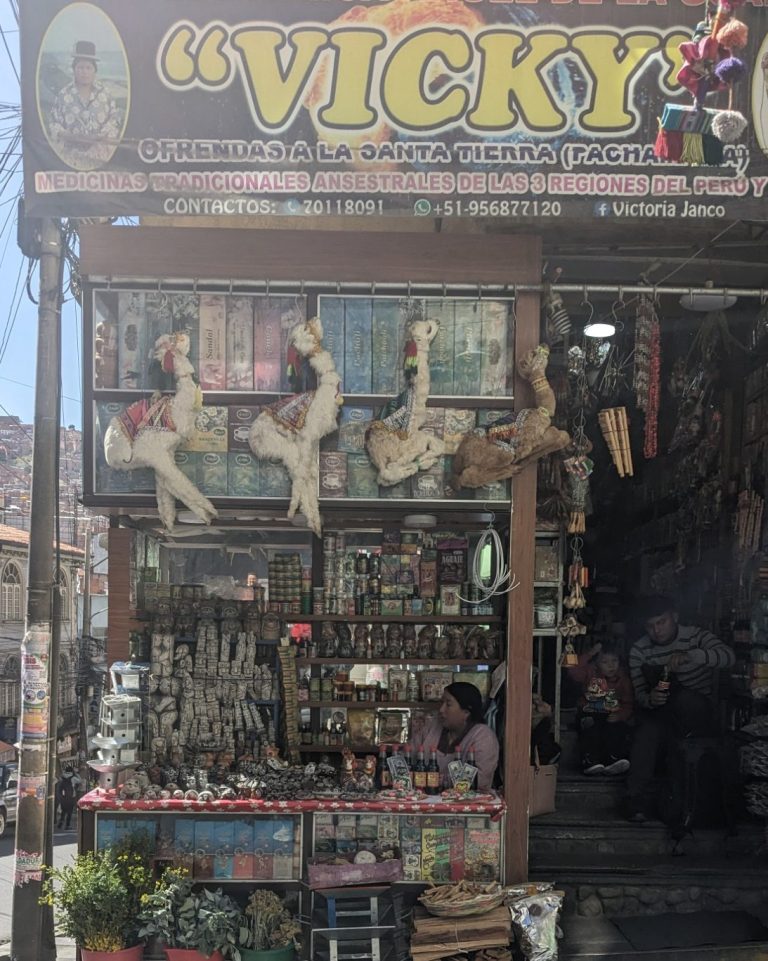
That evening, we couldn’t stop thinking and discussing about San Pedro. The following day, we were also shown culturally how different people live and think here. We stopped at the witches’ market at the beginning of our city tour. This is especially popular with locals to buy carved wooden animals, decorated sugar plates or dead baby lamas. These have different meanings, bring good luck and are often given as gifts. When the guide asked us to sit down, we knew what was bound to come. We had already heard about the creepy rumours in Sucre, but still, our blood was running cold when the guide started with his tale. As mentioned, a dead baby lama is buried under each new house to give an offering to pachamama (mother earth) to protect the future inhabitants. But here it comes. If a building is higher than 20 storeys or particularly important, a baby lama is not enough to satisfy pachamama. For that reason, to this day, there are people buried alive under such buildings. What now sounds like something out of a scary movie is still practised even though it is illegal. Often, homeless people are made to drink large quantities of alcohol and then buried alive under the foundation or a pillar. If a landlord refuses to give this “offering” to pachamama, he can be sure that all the construction workers will refuse to continue working. It is hard to imagine the extent of superstition of what will happen without this sacrifice.
For this reason, there is also the morbid joke that people in Bolivia should not drink too much, or they will be buried alive. In August 2022, this is exactly what happened to a Bolivian. However, he woke up before he was buried alive and immediately reported to the police. When no one would believe him, he turned to the media. Nevertheless, suddenly, it was reported that it had not happened after all. The victim was suspected to be paid a bribe for taking back his story. For all those interested, here is an article on the matter.
After the “horror stories”, we went on to the Mi Teleférico cable car. This was incredibly modern and looked very familiar compared to the rest of the city. No wonder, as we found out later. The company CWA from Olten SO produced the cabins. The world’s largest urban cable car network is a very comfortable way to explore the city.
After the hustle and bustle, we had had enough of the city for the time being and decided to venture out on the famous bike tour on the Death Road (El Camino de la Muerte). Nowadays, it is not as dangerous as it sounds. It was named when vehicles could still drive on it from both directions. Today, most of it is closed to motor vehicles and can only be travelled by bicycle. On a distance of about 65 kilometres, it overcomes 3450 metres in altitude. It crosses almost all climatic zones of South America, from the cold, dry Altiplano to the warm, humid rainforest. Freezing in the morning at an altitude of 4670 m turned into sweating in the jungle.
Huayna Potosí—our first 6000m summit
But now to one of our absolute greatest adventures of the entire trip. After we had been at 3000 metres or higher for more than four weeks, Dominik came up with the proposal about climbing Huayna Potosí, a 6000-metre peak. What Jana dismissed as a dead duck in the beginning, we ended up doing in the end. When will we ever be able to acclimatise for so long again—probably never, so off we went. On the first day, we went to the base camp at 4700 m above sea level, where we learned to use crampons and ice axes on the glacier.
The following night, we realised how valuable our acclimatisation was. Others had to throw up all night or felt completely exhausted the following day and had to abandon the adventure. We continued on to the high camp at 5,300 metres above sea level. Loaded with 18 kilograms of luggage each, the way was quite challenging, and we were glad when we reached the top in one piece. Breathing and eating became even more difficult at this altitude. After a last big meal, we went to bed at 6 p.m. to rest for a few more hours before the ascent. Our big adventure started at 1:30 in the morning. Armed with a helmet, ice axe, crampons and headlamp, we started the approximately five-hour ascent. It felt completely surreal to plod along in the dark on the glacier. You were only concerned with yourself, breathing, belaying and convincing yourself that you could make the climb.
Our guide always told us from the beginning: “few breaks, siempre caminar”. Slowly but steadily, we overtook group after group. But the -15 degrees Celsius and the last 80 metres of elevation particularly took their toll on Jana. But giving up now was out of the question when she had already made it this far. A frozen Snickers bar and encouragement from the guide and Dominik gave her the energy to complete this last section successfully. Entirely overwhelmed by our emotions, we arrived at the top at 6088 m above sea level and were rewarded with an incredible view and sunrise. We really made it! Even now, we can hardly believe it.
Already after 15 minutes, we began our descent. Now, we could see the whole way in daylight—definitely not for the faint-hearted. We quickly got the first section behind us, but Dominik suddenly stopped walking and lay in the snow. He was completely out of energy, felt sick, and his breathing was fast and shallow. With what felt like 100 breaks, we still made it back to the high camp. Jana thought they would have to spend another night there, as she could not imagine how he would manage the challenging walk to base camp with his luggage.
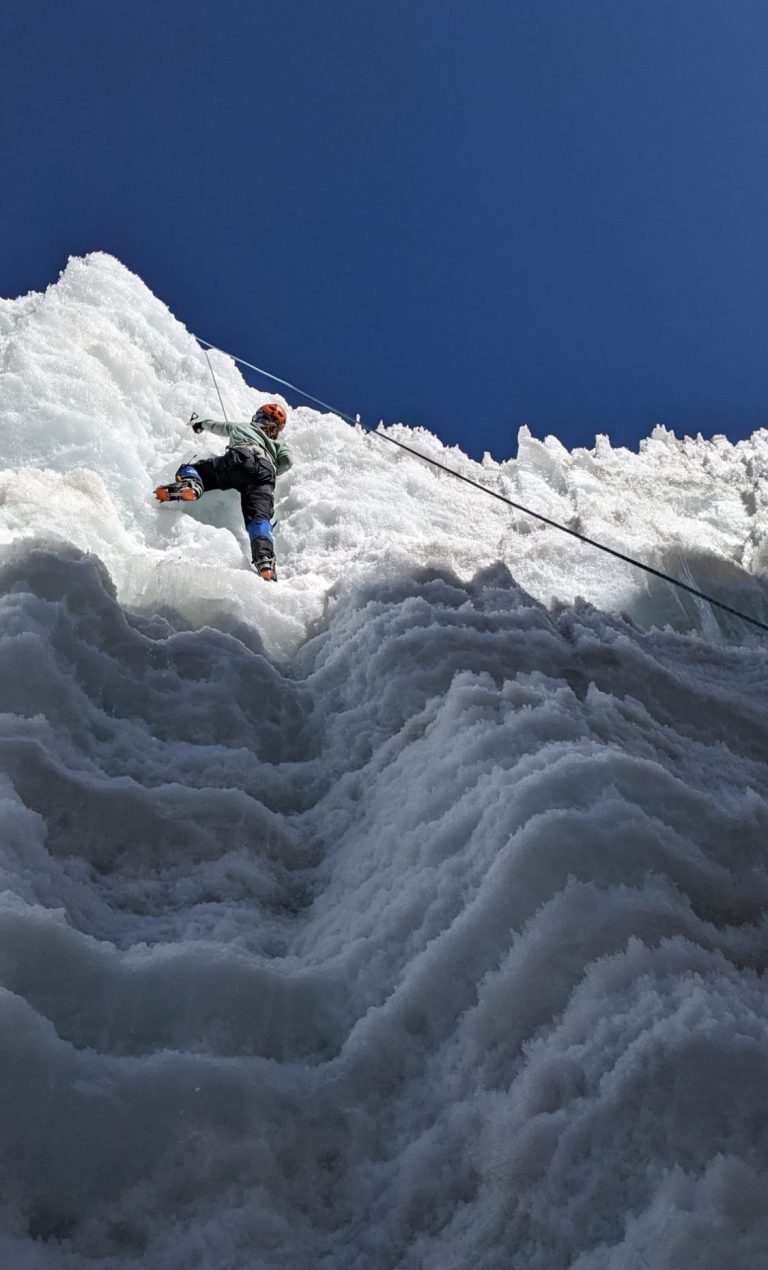

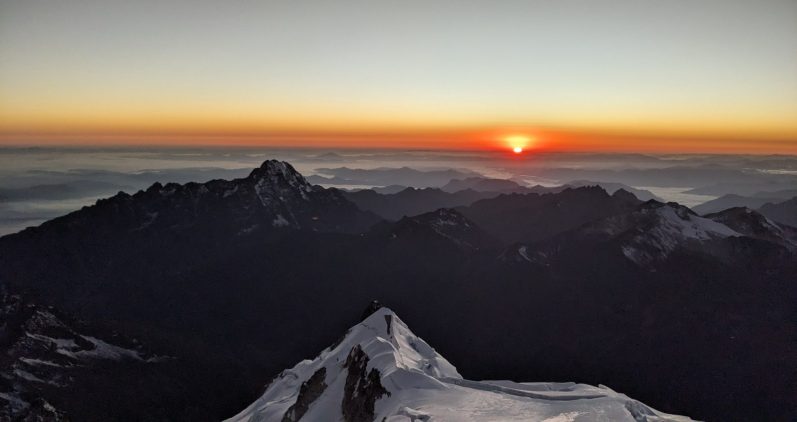
But the guides said these were typical altitude sickness and exhaustion symptoms, and he had to descend, even if they had to carry him. Fortunately, after 1.5 hours of rest, things were already a little better, and we received assistance carrying our luggage. We didn’t have the reward beer after the descent, but we could make up for that later. Totally exhausted, we fell into bed that night and did nothing but sleep and eat until the following evening.
In the Bolivian Amazon
Then, our next adventure started. We took the night bus to Rurrenabaque (Rurre) for our jungle and pampas tour. The heart rate on the journey to Rurre was at least as high as when climbing the 6000m peak. Taxi to the bus station 30 minutes late, wrong bus station, then wrong bus company. And finally, we had a bus driver who overtook in the most impossible spots, which jolted us out of sleep several times due to honking vehicles on the opposite lane. Crumpled but in one piece, we arrived in Rurre. Already two hours later, we were on the boat heading to the jungle, or more precisely, to the Madidi National Park.
The following days were incredible. We spent the first three nights in the jungle. As a group, we decided to spend the second night deep in the wilderness on a mattress protected only by a mosquito net instead of the beautifully designed resort—after all, we love the adventure. Alone to hear the many unknown sounds during the night was outstanding.
When we set off early the next morning to a viewpoint, our guide Luis saw or rather heard a group of “Spider Monkeys”, his absolute favourite animal. Like bitten by a tarantula, we ran off. Luis with his machete ahead, as if he had stepped right out of an Indiana Jones film. We saw the monkeys swinging through the air and playfully dancing from branch to branch.
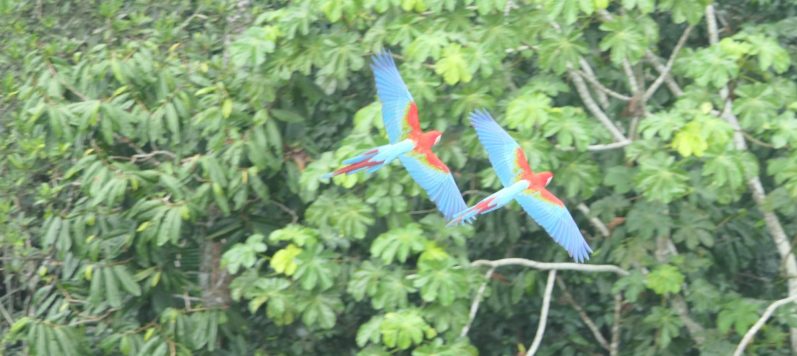
After making it out of the dense forest back onto the path, we reached the viewpoint a short time later. From there, we could observe about 40 red, green and blue coloured parrots, who always travel in pairs. Together, they were flying along the cliffs to get food. The way back at 35 degrees Celsius and 95 per cent humidity was a real challenge, and we finally reached our resort, completely drenched in sweat.
Early the next day, we went on to the Pampas. This is a vast, flat river landscape between the rainforest of the Amazon basin in the north and the dry Gran Chaco in the south. Most of the time, you can only travel by boat and see an incredible number of animals. Already on the first metres, small and curious yellow monkeys greeted us. On the big tour in the afternoon, we also saw countless caimans, turtles, various bird species and pink river dolphins. The following morning, we even spotted one of the cute capibaras. We don’t want to go into much more detail at this point and let the pictures speak for themselves.
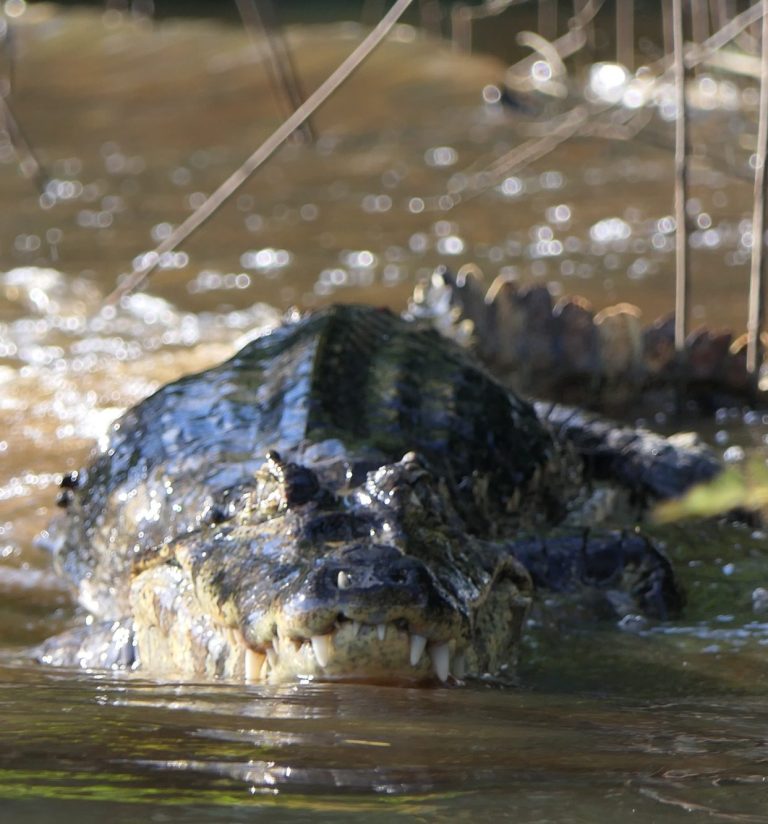
Relaxing at Lake Titicaca
On our way back to La Paz, we decided to take a plane instead of a bus. We did not want to tempt our fate a second time. From the airport in El Alto, we went straight on. With a “collectivo”, which are small minibuses that leave as soon as they are full, we reached Copacabana on the famous Lake Titicaca. We were back from 200 m to 3812 m above sea level in no time. The next few days, we took it easy. We had to process the countless experiences of the last weeks and do nothing for a few days. The only excursion we made was to the picturesque Isla del Sol. We spent the rest of the time in the hammocks in front of our hostel or in a cute café, phoning friends and families, planning our further trip and enjoying the sun.
After five weeks, our time in Bolivia was over. What we experienced in the country can hardly be put into words. After initial scepticism, we were rewarded with one highlight after another. The people were extremely open, friendly and curious. Thanks to our Spanish course, we could now also converse with the locals to some extent. Despite the culture shocks in between, the country is one of our absolute favourites so far.
On a night bus (what else), we continued our journey towards Peru, and it was time to say goodbye to “Bolivia loca”. Also, in Peru, countless experiences await us. Our five-day hike to Machu Picchu, unbelievably good food, our first volunteering, to name a few. But now you’re all probably tired of reading if you have even made it this far. Hasta luego, then hopefully again with a shorter report.
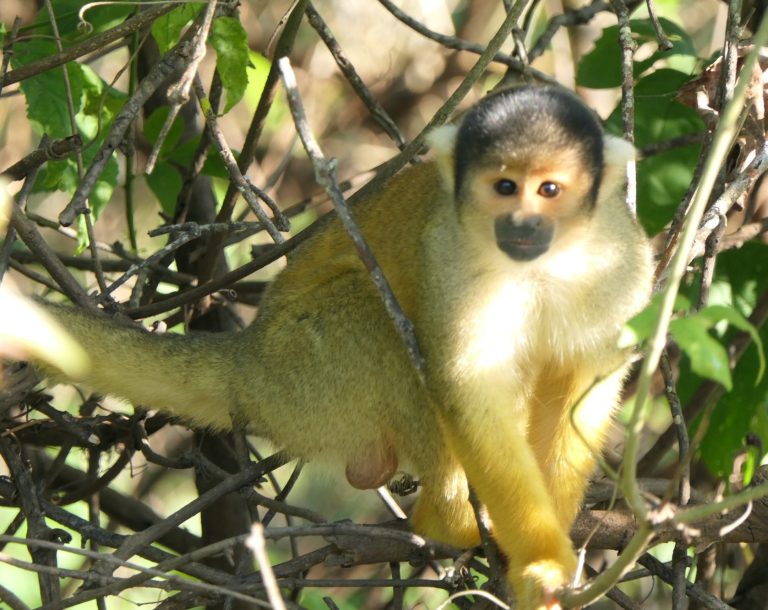

To live up to our name DJ on Tour, here is a song that accompanied us during this time. We just loved the capybaras (thanks Naomi for the song tip).
Gallery
Wir benötigen Ihre Zustimmung zum Laden der Übersetzungen
Wir nutzen einen Drittanbieter-Service, um den Inhalt der Website zu übersetzen, der möglicherweise Daten über Ihre Aktivitäten sammelt. Bitte überprüfen Sie die Details in der Datenschutzerklärung und akzeptieren Sie den Dienst, um die Übersetzungen zu sehen.



